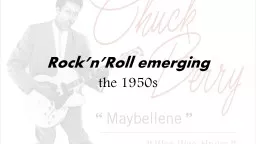

RocknRoll emerging the 1950s 1934 Boswell Sisters Rock and Roll appeared in the film Transatlantic MerryGoRound 1938 Sister Rosetta Tharpe recorded Rock Me for Decca Records ID: 767149
Download Presentation The PPT/PDF document "Rock’n’Roll emerging" is the property of its rightful owner. Permission is granted to download and print the materials on this web site for personal, non-commercial use only, and to display it on your personal computer provided you do not modify the materials and that you retain all copyright notices contained in the materials. By downloading content from our website, you accept the terms of this agreement.
Rock’n’Roll emerging the 1950s
1934: Boswell Sisters, “Rock and Roll” appeared in the film Transatlantic Merry-Go-Round.1938: Sister Rosetta Tharpe recorded “Rock Me” for Decca Records [link]. Her music tried to cross-over from gospel to rhythm and blues. Tharpe had a huge influence on Little Richard, Chuck Berry, Johnny Cash, and Elvis Presley.1942: Maurie Orodeneker began to call more upbeat recordings, such as Thorpe’s “Rock Me” -- “rock-and-roll”. The term “Rock and Roll,” earlier versions
Early 1920s: Radio broadcastingRise of popular music One of the first portable radio receivers, 1923
Long history, began 1877, patented in 1930sBing Crosby, actor, singerUsed to broadcast live on NBC radioTired of live performances: 39 weeks per yearDiscs poor quality soundOctober 1947: first taped broadcastThanksgiving 1947 recording Magnetic Tape Bing Crosby, 1903-1977
1930s: vinyl begins to be used for recording music.1948: Columbia Records introduced the long-playing 331⁄3 rpm microgroove vinyl record, or "LP“.1949: RCA Victor countered with the short-playing but convenient 7-inch 45 rpm microgroove vinyl single. Rise of popular music
1946: Wurlitzer 1015, a selection of 24 (45 rpm) records Jukebox, arose in 1950s 1952: Seeburg M100c: could play 50 different records, 100 choices
Brown versus Board of Education, 1954Separate but equal did not work (Plessy vs Ferguson, 1896).17 May 17 1954, Chief Justice Earl Warren Court unanimously (9–0) decided that "separate educational facilities are inherently unequal.“Victory for Civil Rights MovementFight was just beginning.Led gradually to greater acceptance of A-A culture.
Post World War II Baby Boom, the last
Growing and prospering middle class, especially after WWII (1939-1945)More disposable incomeSpread of leisure, the near necessity to enjoy lifeRecords became cheap and widely available. The city: noisy, light, busy, young The audience
ElectricityArtificial lightTelevision, the new medium, ate up radio demand, provided images of biggest starsGenerational: rock and roll as the primary mode of rebellion during the Cold War The audience
Highly portable, smallmore than car radiosFirst: Regency TR-1, October 1954Sony then made them fast and cheaper.Japanese low wages drove down cost to consumers (by 1962: $15) Transistor Radios 1954: Regency TR-1 Price: $49.95 1955: Sony TR-55 Price: $39.95
Muddy WatersMcKinley Morganfield (1913-1983) Father of Chicago Electric Blues 1941: Alan Lomax recorded him for Library of Congress: link1943: moved to Chicago to become a professional musician.1945: first electric guitar, to be heard over the city’s noise.1946: started recording with Aristocrat Records (Chess brothers).1954: Hoochie Coochie Man (written by Willie Dixon): link Waters essentially brought the Delta Blues to Chicago and electrified it.
Howlin’ WolfChester Arthur Burnett (1910-1976)Charlie Patton taught him guitar and the blues. Already playing an electric guitar in 1941 1951: Sam Phillips recorded him at the Memphis Recording Service: “How many more years” [link]1952: moved to Chicago and signed contract with Chess Records.Waters initially helped him out, but later they became rivals.
Little RichardRichard Wayne Penniman ( born 1932, Macon, Georgia)Began as a gospel singer, mother at New Hope Baptist ChurchFather owned a nightclub: Tip In Inn27 October 1947: Sister Rosetta Tharpe invited him on stage.Played in various bands, often in drag.1951: “Taxi Blues” [link ] 1956: “Long, Tall Sally” [ link ]
Chuck BerryCharles Edward Anderson "Chuck " Berry (born 1926, St. Louis)Wild kid, prison, 1944-1947Moved to Chicago, May 1955Muddy Waters introduced him to the Chess brothers.1955: “Ida Red,” became “Maybellene” [link]
First important Rock “Disc Jockey” DJ“Old King of the Moondoggers”Leo Mintz, Cleveland, Ohio record store ownerWJW (Cleveland): worked the night shift Brought black hot jazz and rhythm and blues to white teenagers .21 March 1952: “Moondog Coronation Ball”Popularized “Rock’n’Roll”6 April 1954 broadcast: link Alan Freed (1921-1965), “Rock ‘ n’Roll ”
1959: Freed began hosting “The Big Beat” on ABC; popular, but lasted only four episodes.Here is why: fourth episode featured “Frankie Lyman and the Teenagers”Freed then faced conflict of interest charges for promoting songs in which he had a financial interest Chuck Berry’s “Maybellene”.Common practice, unevenly enforced. Race and Payola
Chuck Berry shared the royalties: Maybellene, 1955